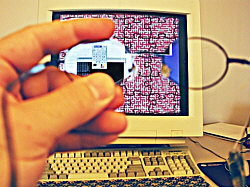So what can you do when you make a product for electronic voting that security experts have shown to be bad for voting due to insecurity? Well, the best possible thing might not be to make sure the touch screens on those devices will cause them to fail poorly when touched, wouldn’t you think? Yet that’s what happens to the Diebold e-voting machines right now. Thankfully Diebold has a fix – don’t touch the touchscreen. And the company will provide a mouse for every machine.
After a daylong test of the state’s retrofitted voter check-in computers, it remained unclear yesterday whether the $18 million system works well enough for the state’s elections chief to deploy it in the November general election.
. . .
One reason for the relatively smooth test was the addition of a computer mouse to each of the touch-screen terminals, bypassing a software flaw first identified during the Sept. 12 primary and which remained unsolved throughout the day yesterday.
. . .
The e-poll books are supposed to be operated by tapping a small plastic stylus against the computer screens. The terminals are linked together and are used to register, among other things, whether a voter has shown up at the polls.
But during last month’s primary election, on occasion, one machine in a precinct would show voters as having cast ballots, while another would say they had not come to the polls.
To fix the problem, Diebold officials said yesterday the units could be operated with computer mouses and that they could provide the state with 5,500 of them in time for the general election. Or they could install new software and allow election judges to touch the screens.
Yes, you are reading that right. To use the touch-screen based e-voting machines, one has to use a mouse and not touch the touch-screen. If someone does use the touchscreen, well, the device could lose connectivity with the rest of the systems and require a reboot. After the reboot, the user might still be able to vote, but apparently their vote from before the reboot will still be kept in the system. Instant doubling of votes, just by touching the touchscreen after voting!
Lamone’s deputy, Ross Goldstein, said yesterday that elections officials would hear from their quality-assurance consultants and Diebold about whether the underlying software flaw causing the machines to lose sync could be fixed before a mid-October deadline to return the improved units to local election boards.
. . .
When the e-poll books fail to communicate with each other, or “lose sync,” the lists of who has voted in that precinct, which are stored on the e-poll books, don’t match. Should someone try to vote again, an out-of-sync system wouldn’t flag the double vote until the system had been corrected.
A spokesman for Diebold said yesterday that likelihood of such fraud would be low. If the system requires mouses, poll workers would be instructed repeatedly not to touch the screens and to check whether the system is communicating properly.
They also said that yesterday’s test proved that the system works smoothly and that the mouses would not interrupt an election.
OK, I’ll grant – the mouse probably won’t interrupt the election. But I bet all the people touching the touchscreens will. I wonder if anyone else worries about that?
County elections directors, many of whom came to the event, heaped praise on the machines, saying that they eliminated days of work updating voter histories after the election.
“Your instinct is to touch the screens,” said Sandra M. Logan, elections director in Caroline County, as she checked in a voter. “But I think my judges are used to using mouses and would like them.”
Nope. Or at least the elections director isn’t. Because people trained to not use the systems the wrong way after 2 test runs have mostly learned how to not use the systems the wrong way. Which I’m sure will translate into 100% non-misuse in a real election.
The likelihood for fraud if this problem stays in is high. Anyone saying otherwise is flat out lying to anyone that listens. There are groups of people who will do anything to tamper with an election (and no, I’m not talking about liberals). Once they know about a flaw this easily exploitable, they will take advantage of it. Saying the likelihood of fraud is low is akin to saying you trust the criminals will not try to take advantage of a flaw once they are made aware of it. And that would be laughable if it weren’t such a serious issue.
[tags]Diebold voter machines work great as long as not used in manner designed for,Easily exploitable flaw in Diebold e-voting systems no cause for concern according to Diebold[/tags]

